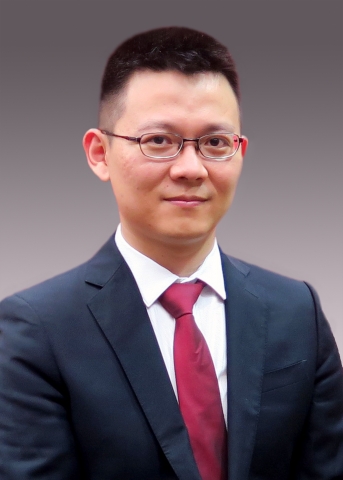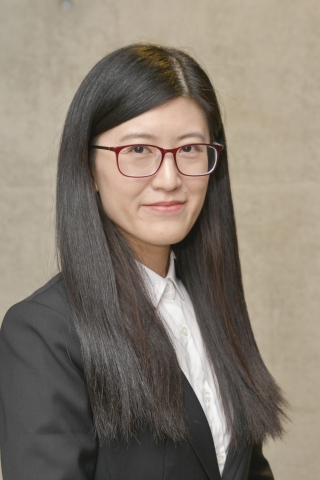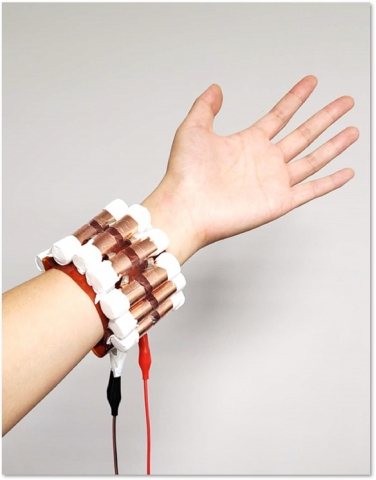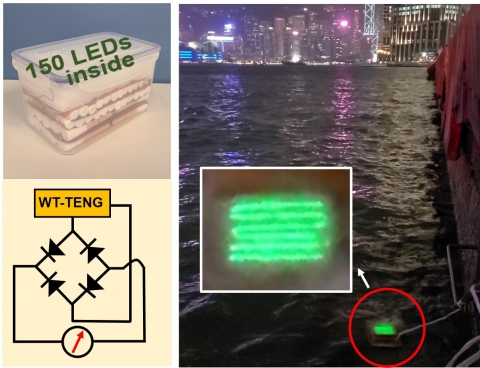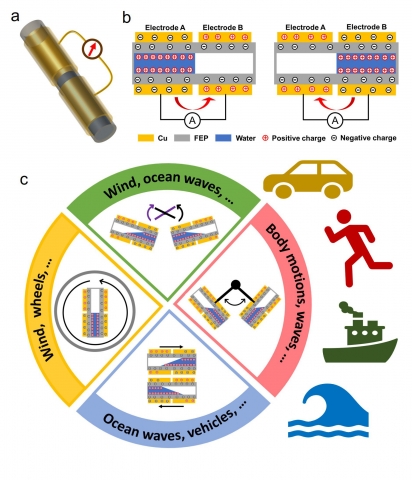A research team from the Faculty of Engineering has recently developed a water-tube-based triboelectric nanogenerator that can efficiently convert various irregular and low-frequency mechanical energies, including ocean wave energy, into electricity, providing a new avenue for the development of “blue energy”. The ocean covers about 70% of the Earth’s surface area and is the largest reservoir of energy. Researchers have been exploring the approach for harnessing ocean energy to solve the world energy crisis and pollution problems caused by thermal power generation. The nanogenerator, including piezoelectric, triboelectric, and pyroelectric nanogenerators, is one of the key technologies for mechanical energy conversion. The triboelectric nanogenerator (TENG) makes use of the triboelectric effect and electrostatic induction to harvest mechanical energy based on contact or sliding electrification. However, conventional TENG device is often based on solid/solid contact, and it is hard to ensure the contact intimacy of the two tribo-materials. In the meanwhile, the material surfaces will wear or become damaged after long-term friction. Also, the solid/solid-based TENGs need shell structures and/or mechanical components such as springs, holders, and rotors to harvest random vibration energy. The complex structure will reduce the efficiency of energy harvesting. The research team led by Prof. Zi Yunlong, Assistant Professor of the Department of Mechanical and Automation Engineering at CUHK, has recently overcome the above technical limitations and developed a water-tube-based TENG (WT-TENG) for irregular and low-frequency environmental energy harvesting, such as water waves. They encapsulated water in a finger-sized tube (FEP). When water moves in the tube between regions of the two electrodes, triboelectrification happens and electric currents can be generated. Taking advantage of the flexibility of water, the WT-TENG can be operated in various modes, including rotation, swing, seesaw, and horizontal linear modes, to harvest energy from diverse mechanical movements in the environment, such as ocean waves, wind, body and vehicle movements. Due to the high contact intimacy of water and the tube surface, the output volumetric charge density of the WT-TENG is significantly enhanced, reaching 9 mC/m3 at a frequency as low as 0.25 Hz, which is beyond all previous reports. Moreover, just like toy building bricks, multiple small WT-TENG units can be easily combined and integrated as one larger unit and realise multiplied electric outputs. Researchers designed two power generation units. One is a box with 34 WT-TENG units which was placed in the sea to collect ocean wave energy. Another one is a wristband composed of 10 WT-TENG units. A researcher put it on and kept swinging her arms for body motion energy harvesting. The peak power generations of the two tests were both enough to drive 150 LED light bulbs. Prof. Zi Yunlong stated, “Previous designs of ocean energy harvesters have been equipped with electromagnetic-based generators which are large in size and heavy, and will only generate power if the frequency of ocean waves reaches a certain high level. Our latest research has overcome the technical hurdles and will promote the use of nanogenerators, especially in “blue energy” harvesting, offering a new direction for the development of renewable energy to achieve carbon neutrality.” Related research results were recently published in the internationally renowned journal Advanced Energy Materials. The first author of the article is Postdoctoral Fellow Dr. Wu Hao, and Professor Zi Yunlong is the only corresponding author. Professor Wang Zuankai from the City University of Hong Kong participated in the guidance of this work. About Prof. Zi Yunlong Prof. Zi Yunlong joined CUHK in 2017. He has been working on energy harvesting through the emerging TENG technology and self-powered systems, with a series of independent research achievements and several awards. This project was funded by the Early Career Scheme of Research Grants Council, the Innovation and Technology Fund of the Innovation and Technology Commission of the Hong Kong SAR, Shun Hing Institute of Advanced Engineering, and Guangdong Basic and Applied Basic Research Fund. |
|


